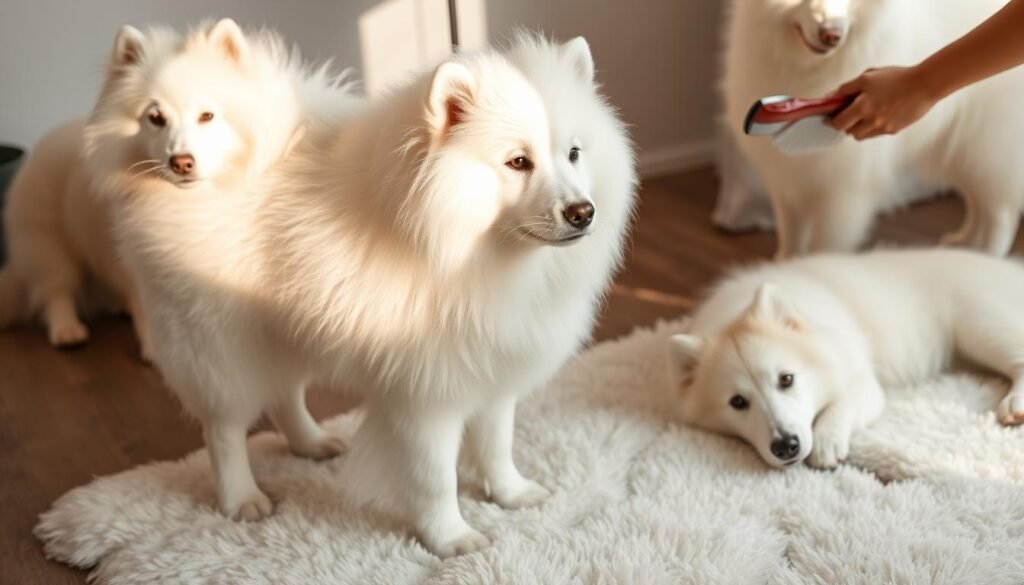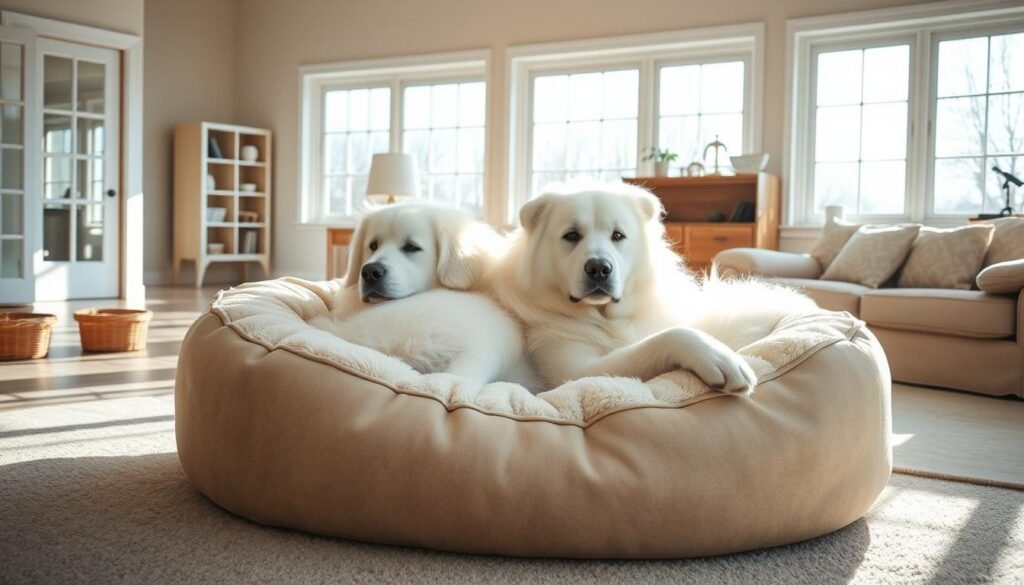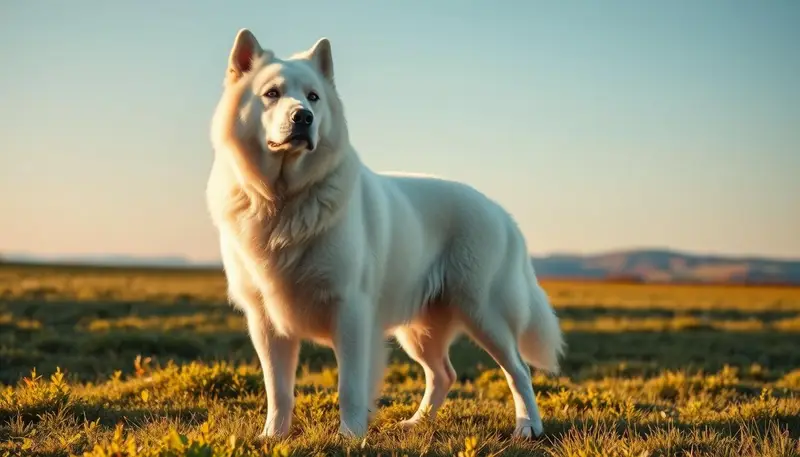Large White Dog Breeds: The Ultimate Guide to Gentle Giants
Table of Contents
Thinking of getting a gentle giant for your family? You’re not alone. Many people love big white dogs for their beauty and kind hearts. These white coated breeds are not just beautiful, but also great friends.
Exploring large white dog breeds reveals their special traits. You’ll learn about their history and personalities. This guide aims to give you a deep understanding of these amazing dogs.
Whether you’re new to dogs or have experience, this guide is for you. It will help you find the right gentle giant for your family.
The Majestic World of Large White Dog Breeds
Large white dog breeds are known for their stunning looks and deep bond with their owners. These white fur dog breeds are not just beautiful but also very loving and gentle.
What Defines a Large White Dog
A large white dog is big and has a mostly white coat. They weigh over 50 pounds and are very tall. Their white coat can range from pure white to cream, making them even more beautiful.
The Special Appeal of White-Coated Giants
The charm of these popular large white dogs comes from their looks and the meanings they carry.
Aesthetic Qualities
The beauty of white colored dog breeds is clear. Their coats symbolize purity and grace. This makes them winners in dog shows and beloved family pets.
Symbolic Significance
White dogs often mean loyalty, innocence, and protection in different cultures. This adds a special layer to their charm, making them more than pets. They become companions with a rich cultural background.
| Breed | Weight Range (lbs) | Height Range (inches) |
|---|---|---|
| Great Pyrenees | 85-115 | 25-32 |
| Samoyed | 35-65 | 19-23 |
| Kuvasz | 70-115 | 26-30 |
Most Popular Large White Dog Breeds in America
In America, the most sought-after large dog breeds are the white-coated giants. They are known for their beauty and loyalty. These top white large canines have won the hearts of many dog owners. Their majestic appearance and diverse characteristics make them stand out.
Great Pyrenees
The Great Pyrenees is a standout among big white fluff dogs. Originally bred to guard sheep, this breed is protective yet gentle. They have a thick double coat that needs regular grooming.
Physical Characteristics
The Great Pyrenees has a muscular build and a thick coat, which is white or white with markings. They are large, with males weighing up to 100 pounds.
Temperament and Personality
Despite their size, Great Pyrenees are gentle and even-tempered. They are loyal to their families and can be protective when needed.
Samoyed
The Samoyed is another popular breed in the white giant breeds category. Known for their smiling faces and fluffy coats, Samoyeds are friendly and outgoing.
Physical Characteristics
Samoyeds have a thick, white coat that needs regular grooming. They are medium to large, with males weighing between 45-65 pounds.
Temperament and Personality
Samoyeds are highly social dogs that thrive on interaction. They are intelligent and active, needing regular exercise and mental stimulation.
Kuvasz
The Kuvasz is a Hungarian breed known for its intelligence and protective nature. As one of the top white large canines, the Kuvasz is a loyal companion and guardian.
Physical Characteristics
Kuvaszok have a thick, white coat that is dense and weather-resistant. They are large, with males weighing up to 115 pounds.
Temperament and Personality
Kuvaszok are known for their loyalty and protective instincts. They are intelligent and trainable but can be independent at times.
In conclusion, these breeds are among the most popular white giant breeds in America. Each has unique characteristics and traits. Whether you’re drawn to the gentle Great Pyrenees, the social Samoyed, or the loyal Kuvasz, there’s a large white dog breed for you.
Guardian and Working White Giants
Large white dog breeds look majestic but have a strong working background. They were bred for their size, coat color, and to protect and serve.
Maremma Sheepdog
The Maremma Sheepdog comes from Italy and is known for guarding. It protects sheep from predators. They are great watchdogs because of their guarding instinct.
“The Maremma Sheepdog’s loyalty and protective nature make it an invaluable asset to farms and families.”
Akbash
The Akbash is famous for guarding. It comes from Turkey and guards livestock against wolves and bears. They are quick to respond and have sharp senses.
Polish Tatra Sheepdog
The Polish Tatra Sheepdog guards livestock in the Tatra Mountains. They are built strong and have a protective nature.
Working History
These breeds have a long history of guarding. Their roles have changed, but their protective instincts remain strong.
| Breed | Origin | Primary Use |
|---|---|---|
| Maremma Sheepdog | Italy | Guarding sheep |
| Akbash | Turkey | Guarding livestock |
| Polish Tatra Sheepdog | Poland | Guarding livestock in mountains |
Modern Guardian Abilities
Today, these breeds guard not just livestock but also families and homes. Their loyalty and protective nature make them great companions.
Knowing their working history and guardian abilities today shows their value as pets and working dogs.
Arctic and Northern Large White Dog Breeds
The Arctic and Northern regions have created amazing large white dog breeds. These dogs are built for cold weather and have special traits that set them apart.
White Swiss Shepherd
The White Swiss Shepherd is known for its white coat and herding skills. It comes from the Swiss Alps and is smart and loyal, like the German Shepherd. But it’s also calm and gentle, making it a wonderful pet.
American Eskimo (Standard)
The Standard American Eskimo dog is beautiful and agile and loves cold weather. They have white coats and lots of energy, making them great at dog sports. They’re friendly and outgoing, perfect for families.
White Alaskan Malamute Variants
White Alaskan Malamutes are powerful and enduring dogs made for the Arctic. They look different because of their white coat, but they’re still Malamutes.
Relation to Other Breeds
White Alaskan Malamutes are close to other Malamutes but have a different coat color.
Unique Temperament Traits
White Alaskan Malamutes are independent and strong-willed. They need owners who can train them well and give them lots of exercise. Despite being independent, they are very loyal and loving.
These Arctic and Northern large white dog breeds are not just beautiful. They also have unique traits shaped by their environments. Whether you like the White Swiss Shepherd’s herding, the American Eskimo’s agility, or the White Alaskan Malamute’s strength, there’s a breed for you.
White Retriever and Companion Breeds
Large white dog breeds, like white retrievers and companions, are loved by many. They are known for their beautiful looks and their loyal, loving nature.
White Golden Retriever
The White Golden Retriever is a special type of Golden Retriever. They have a light cream to white coat. They are friendly, loyal, and gentle, perfect for families.
White Labrador Retriever
White Labrador Retrievers are a part of the Labrador Retriever family. They have the same intelligent and outgoing personality as others but with a white coat.
Dogo Argentino
The Dogo Argentino is a big, muscular dog with a white coat. They were bred for hunting big game and are powerful and athletic.
Genetic Background
They come from a line of hunting dogs. This makes them highly energetic and strong-willed.
Family Compatibility
Even with their hunting background, Dogo Argentinos can be loyal and loving family pets. They need proper socialization and training.
| Breed | Coat Type | Family Compatibility |
|---|---|---|
| White Golden Retriever | Thick, double coat | Excellent |
| White Labrador Retriever | Short, dense coat | Very Good |
| Dogo Argentino | Short, smooth coat | Good with proper socialization |
Grooming and Maintaining White Coats
Keeping a large white dog’s coat clean and shiny takes effort and the right methods. These dogs are not just beautiful; they need regular grooming to stay that way. This helps avoid stains and mats.
Dealing with Shedding
Shedding is common in many dogs, including those with white coats. Brushing them often helps control shedding. It also stops loose hair from causing skin problems or getting tangled.
For dogs like Samoyeds or White Swiss Shepherds, brushing every day is best.

Stain Prevention and Treatment
Stains on white coats can be hard to get rid of and look bad. Cleaning them regularly, especially around the eyes and mouth, can stop stains. For tough stains, a mix of water and white vinegar works well.
It’s also important to dry your dog’s coat well after a bath. This stops dampness from causing color changes.
Professional vs. Home Grooming
Choosing between professional grooming and doing it at home depends on your dog’s needs and your preference. Professional groomers are great for detailed tasks. But, you can often groom your dog at home with the right tools and knowledge.
Seasonal Considerations
Seasons can change your dog’s grooming needs. For example, more brushing is needed during shedding season. In winter, using moisturizing shampoos helps with dry skin.
Best Brushing Tools
Choosing the right brushes is key for your dog’s grooming. Slicker brushes are good for removing tangles and mats. Pin brushes are gentler for everyday grooming.
For dogs with thick undercoats, an undercoat rake is very helpful.
Health Concerns Specific to Large White Dog Breeds
Large white dog breeds are stunning, but they face health challenges. Knowing these health issues is key to caring for your pet.
Genetic Predispositions
These breeds often have genetic health problems. For example, some may get hip dysplasia.
Skin and Coat Issues
Their white coats can lead to skin problems like allergies. Regular grooming helps spot these issues early.
Preventative Health Measures
Preventing health problems is as vital as treating them. Regular vet visits, a balanced diet, and exercise are crucial for your dog’s health.
Hip and Elbow Dysplasia
Hip and elbow dysplasia are common in large breeds. These issues cause arthritis and mobility problems. Keeping your dog at a healthy weight and using joint supplements can help.
Allergies and Sensitivities
Allergies and sensitivities can cause skin, digestive, or ear problems. Identifying and avoiding allergens, along with vet care, can manage these issues.
| Health Issue | Symptoms | Preventative Measures |
|---|---|---|
| Hip Dysplasia | Pain, limping, difficulty standing | Maintain healthy weight, joint supplements |
| Allergies | Skin irritation, digestive issues | Avoid allergens, regular veterinary check-ups |
Understanding health concerns in large white dog breeds helps you care for your pet. This ensures they live a healthy, happy life.
Training and Socializing Your Gentle Giant
To get the most out of your gentle giant, it’s key to focus on training and socialization. Large white dog breeds are known for their grand look and kind heart. They need careful teaching to be good family pets.
Early Socialization Importance
It’s vital to socialize large white dogs early on. This helps them get used to different places, people, and animals. It builds their confidence and keeps them calm. Start socialization when they’re 8 weeks old and keep it up during their early months.
Effective Training Methods
Training large white dogs needs patience, consistency, and positive feedback. Using reward-based training is best. It encourages good behavior without making them scared or aggressive.
Addressing Breed-Specific Behaviors
Different breeds have their own ways of acting. For example, some large white dogs are naturally protective.
Positive Reinforcement Techniques
and
Consistency Approaches
can help manage these behaviors.
Knowing and dealing with breed-specific traits lets you tailor your training. This ensures a happy home for everyone.
Living Arrangements for Large White Dogs
Thinking about getting a large white dog? It’s key to consider the living space you have. These dogs can be great additions to many homes. But, they need the right conditions to be happy.
Space Requirements
Large white dogs need lots of room to move. A big home with a yard is best. But, if you live in an apartment, long walks and playtime can help.
Climate Adaptations
Some large white dogs love cold weather, while others prefer it warmer. Find out what your dog needs to live comfortably.
Family and Other Pet Compatibility
Adding a large white dog to a home with other pets or kids needs thought. Start socializing early to keep peace among pets.
Indoor Considerations
Large dogs need cozy indoor spots. Make sure your home has enough room for them to rest comfortably.
Yard and Outdoor Access
A fenced yard is crucial for many large breeds. It gives them a safe place to play and exercise.

Nutrition and Exercise for Large White Dog Breeds
To keep your large white dog breed in top shape, knowing their diet and exercise needs is key. A balanced diet and the right exercise plan are vital for their health and happiness.
Dietary Requirements
Large white dog breeds need a diet full of proteins, some fats, and few carbs. High-quality dog food with omega-3 fatty acids is good for their coat and skin.
Exercise Regimens
Regular exercise is a must for these dogs. They need daily walks, playtime, and mental challenges to avoid boredom and obesity. Aim for at least 60 minutes of exercise per day, which can include running, hiking, or playing fetch.
| Breed | Daily Exercise Needs | Dietary Considerations |
|---|---|---|
| Great Pyrenees | 60 minutes | High protein, balanced fats |
| Samoyed | 90 minutes | Moderate protein, low carbs |
| Kuvasz | 75 minutes | High protein, moderate fats |
Weight Management
Keeping a healthy weight is key to avoid obesity-related health problems. Watch their food intake and adjust their exercise as needed.
Puppy Growth Considerations
Puppies need a diet rich in nutrients for growth. Make sure they eat puppy-specific food until they grow up.
Daily Activity Guidelines
Finding Your Perfect Large White Dog
Looking for the perfect large white dog is an exciting journey. You might be drawn to the majestic Great Pyrenees or the friendly Samoyed. Bringing a new furry friend home is a big decision that needs careful thought.
Reputable Breeder Research
It’s crucial to research a reputable breeder. Look for breeders who are open about their dogs’ health and temperament. They should offer health clearances for the puppy’s parents and answer your questions about the breed and ancestry.
- Check for membership in breed-specific clubs or national kennel clubs.
- Ask about the health guarantees they offer.
- Visit the breeder in person to see the conditions in which the dogs are kept.
Rescue and Adoption Options
Adopting a large white dog from a rescue can be fulfilling. Many rescue groups focus on specific breeds, like Great Pyrenees or Samoyeds.
“Adopting an adult dog can be less demanding than raising a puppy, as they’re often already house-trained and less destructive.”
Puppy vs. Adult Adoption Considerations
Choosing between a puppy and an adult dog depends on your lifestyle. Puppies need more time and training. Adult dogs may have established personalities.
Questions to Ask
When adopting, ask several important questions:
- What’s the dog’s temperament like?
- Has the dog been socialized with people and other animals?
- Are there any known health issues?
Evaluating Adult Dogs
When looking at an adult dog, watch how it acts around you and others. Think about its energy level and trainability to see if it fits your lifestyle.
Conclusion: Is a Large White Dog Breed Right for Your Family?
Exploring large white dog breeds, you might wonder if one is perfect for your family. Their majestic looks and loving nature attract many. It’s clear why they’re so appealing.
Thinking about family compatibility means looking at your lifestyle and living situation. You also need to consider the needs of a large white dog. This includes grooming, exercise, training, and socialization.
Breeds like the Great Pyrenees, Samoyed, and Kuvasz are great for active families. They need care and attention. Knowing their needs helps you decide if a large white dog is right for you.
With the right care and love, a large white dog can bring joy and companionship. Take time to research and prepare. This ensures a happy and healthy relationship with your new furry friend.

